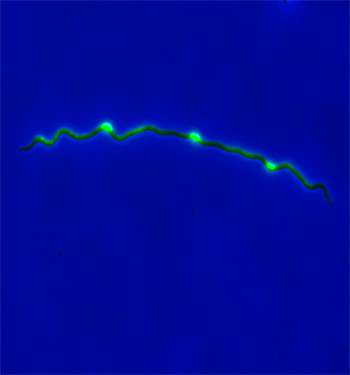Lyme bacteria mark out cell division locations for their progeny

Among bacteria, the spirochetes are characterized by their spiral shape and remarkable length—as much 50 times longer than most other bacteria. This can make cell elongation and division a laborious process. One of those spirochetes, Borrelia burgdorferi, which causes Lyme Disease, has evolved an unusual way of doing this process: Borrelia cells mark the location where their daughters will divide before dividing themselves.
A Yale team led by Christine Jacobs-Wagner, director of the Microbial Sciences Institute, captured the process via single-cell microscopy. They found that spirochetes showed active synthesis of peptidoglycan—a key component of growth and division—at equally spaced regions along its length (seen here in green). These zones of growth not only defined where the mother cell would divide, but also where future daughter cells would divide as well.
The research is published in the journal Proceedings of the National Academy of Sciences, along with a question-and-answer article in which Jacobs-Wagner discusses the mysteries of bacterial growth and division.
More information: Brandon Lyon Jutras et al. Lyme disease and relapsing feverelongate through zones of peptidoglycan synthesis that mark division sites of daughter cells, Proceedings of the National Academy of Sciences (2016). DOI: 10.1073/pnas.1610805113
Journal information: Proceedings of the National Academy of Sciences
Provided by Yale University
















